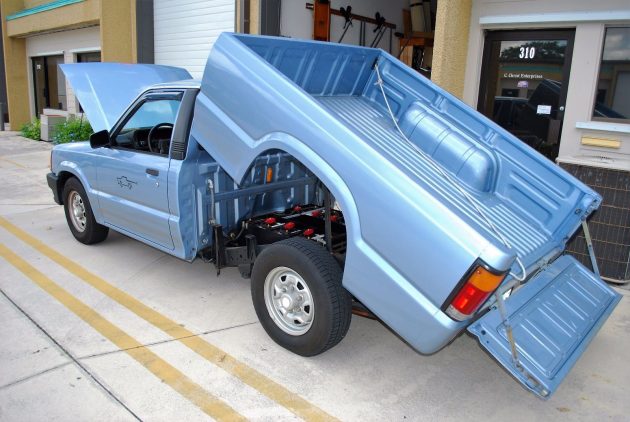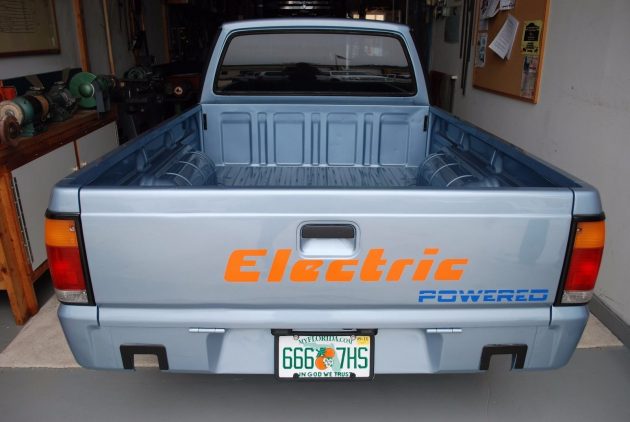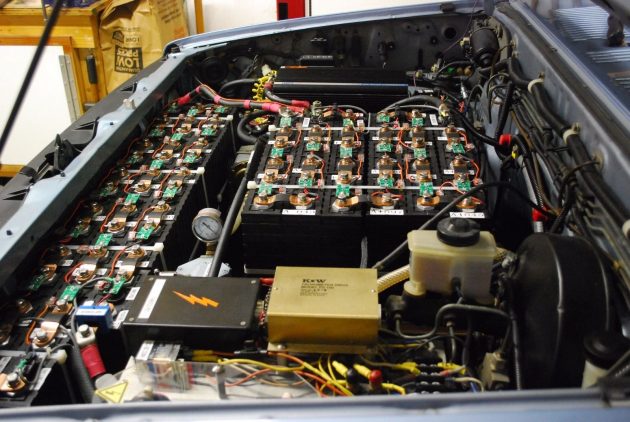This one is newer than we like to show here, and it wasn’t found in a barn; so those are two strikes. The next part may be strike three for most of you, but I hope that a few of you can appreciate the work that’s gone into this nice pickup. It’s a 1991 Mazda B2200 EV Pickup and it’s located in Stewart, Florida. It’s listed on eBay with bids coming in at just over $500! Of course, the reserve isn’t met, and the seller says that it was recently appraised at $10,000 and I don’t doubt that one bit. It’s a nice truck; different, but nice.
The owner has “Shock Hazard” painted on this truck, hopefully that’s just its nickname. They say that it’s in “excellent condition w/4 new tires, converted to battery power using the original drive train with Std Trans.” I’m guessing that means sans the original 2.2L, 85 hp, gas-powered engine, because this is what it looks like under the hood now! That ain’t no 2.2L, 85 hp, gas-powered engine! The truck has “Clear Coat Paint and a tilt bed for future expansion of Batteries.” That’s what the tilt-bed photo is all about! That in itself is a super unique feature and makes me like this truck even more. I don’t see a mention of the model, but I’m guessing that this is the base model which doesn’t have a tachometer or a rear step bumper; this truck has neither of those.
I’ll just mention the license plate number before anyone else does. I would probably want a different plate number, you don’t need any more heat when you live in Florida and are sitting on and/or behind “38 Lithium 3.8v 100ah Sinopoly Batteries” The truck itself is in fantastic condition, whether it’s powered by a gas engine, batteries, or a coal-powered generator. This one looks like it’s perfect underneath and may have been beefed up a bit to carry the extra load? There is no mention of the weight of this truck with the batteries. Any guesses? It has four new tires which I’m guessing you’d want to keep an eye on with that much weight on them.
There are only three interior photos, and none that really shows anything but a close-up of the dash and steering wheel, the one above; and this one. It shows that the “computer controlled charging and operation and can be connected to a lap top for visual graphics.” I guess, they also show a close-up photo of that connection in the dash. This truck has 133,000 miles on it but has “under 500 miles since electric conversion.” There is literally an entire box of files that documents the conversion.
Here’s where the bulk of the batteries sit, under the hood. Instead of the gas engine it has an “advanced 9.5 ” DC Motor and a Curtis Controller.” The seller mentions that they have “$20K invested (Orig cost of battteries $7K, Original cost of drive train $7K).” Like the license plate, I’ll say this before anyone mentions it: that’s a lot of money to spend on batteries just to save money on gas costs. They say that the conversion “was originally based off lead-acid batteries, recently converted to Lithium-Ion.” But, like a lot of these things, it’s not just about saving money, some owners have different ideas as to why they think these vehicles are important and that’s all that matters. This is a heck of a truck. Even at the “appraised” value of $10,000 it would be super interesting to own and drive, just for commuting, of course. The truck, in general, looks very nice and I’m sure that for commuting around town it would be great. Are any of you fans of EV conversions or are you a combustible-fuel-only type of person? I could go either way on this truck, I’d love to have one in either EV or gas-power configuration, or both.







Imagine crashing such a conversion with hundreds of pounds of lead-acid batteries out front – yikes!
Blueprint, this vehicle doesn’t have lead-acid batteries, it was converted to Lithium-Ion power as per the last paragraph. Although, Lithium-Ion batteries are still not ideal in a crash. Just think of crashing in a motorcycle, that can’t be good, either.
That’s what I meant- prior to the conversion!
Kinda cool. I wonder if it would do a burnout?
I would think so. Electric motors are instant torque with pretty much no curve. It ought to smoke ’em.
Hum… No mention of performance good or bad. At least a comparison to the gas motor maybe? How about charge rate, range on a charge, or possibly top speed?
Like so many other advertisements, “I wanta’ sell this… You wanta buy it”? That’s the best you get most of the time.
JW454, I contacted the seller and just heard back. The range is 30 miles +/-, depending on the charge, temperature, etc., and it takes about 6 hours to charge. It’s a daily commuter for sure, no long-distance duty here. The weight is about the same as it was when it had a gas-powered engine.
Scotty,
Thanks for the information. This was more of a commentary on the lack of pertinent facts that should be included in a sale advertisement rather than a curiosity of this particular vehicle. For example, some ads go into great detail regarding the origin of the design of an automobile rather than the pros and cons of the example they are selling. Sorry for the rant. Just a pet peeve of mine.
30 miles a charge…. That’s awful that wouldn’t get you hardly any where.
Willis, as I said, this is a commuter vehicle, 10 miles to work, 10 miles home, then charge it up again. 30 miles is more than enough range for the vast majority of folks commuting to work every day.
I can appreciate the builder’s efforts here. Daring to be different and determined to do a good job. Electric cars (newer than a 1918 Detroit Electric) are not my cup of tea but that’s just me. I still like to hear the sound of an internal combustion engine instead of something like the wife’s vacuum cleaner when I step on the accelerator. However we’re going to have to move over and let some of this newer electric technology move in alongside because it’s going to whether we like it or not.
Somehow I think the range certainly could be better. My bicycle can do over 60 miles per charge (about 40 miles without pedaling). And, there’s no extra cab on this truck. So, it’s a nice looking little pickup and the workmanship seems like quality, but you can’t go further than 15 miles and that ain’t far.
It still seems that the Volt is the only way to keep on going when there’s no more charge left in the batteries. An aux. power source keeps you going and gets you home.
I agree, Kent. Maybe with the old batteries in there I could see a 30-mile range, but not with the new ones. I also agree on the Volt, that’s a heck of a great piece of technology, not to mention one of the highest-rated cars for reliability and owner satisfaction. The BWM i3 has a “range extender”, but it’s basically a small motorcycle engine and it doesn’t charge the battery like on the Volt, so you’ll have to stop for gas every time the small gas tank runs out, which will be often. I’m going to seriously look at the Volt for my next business road trip car.
Hi Scotty. You know I was extremely skeptical of the Volt when it first came out but I saw one the other day and the owner(s) are completely satisfied with it. True it hit them pretty hard in the pocket book when they bought it but they said that it’s done real well for three years now. The only drawback is going to be replacing batteries which they’ll have to do eventually. But then, we all have to replace batteries eventually; most of us don’t have to replace as many…
Hi Geo, I’m still on my original batteries on my road trip car, Prius.. with about 170,000 miles on them and still going as strong as when it was new five years ago. Even if I have to replace them that’ll be around $1,500, I save that much every year easily, not to mention I charge $0.50 a mile so it’s a no-brainer for me.
That’s pretty reasonable for battery replacement. My brother has a Lexus SUV Hybrid and he isn’t all that happy with it. He replaced batteries after two years and he’s having problems with them again two years later. It seems to me that the first time they cost him a bundle (considerably more than $15K) and that was mostly disposal fees for the old ones. He says it’s still doing better than his friend’s ‘Insult.’ He says that’s got to be the worst POS ever made. I reminded him of my import pickup of days gone by. We had a good laugh over that one.
I’ve often thought that the concept of a train locomotive would be a realistic approach. The Chevy volt comes close. I think it would make more sense for example in a pickup truck to have a small fuel efficient diesel driving a DC generator that would in turn powers a DC electric motor attached to the conventional transmission and drive line. Imagine if you will driving say a 1 ton truck down the road with equal or more power to the rear wheel while getting 100 mpg. Yes your still burning fuel but a fraction of what you used to burn before, without the concern that the electric cars have with range, and no big bank of batteries to replace for thousands of $$$$. This works for trains, they move over a 100 train cars down the track for under $10 per mile. I think that this would be much simpler to build with in the long run and a lesser impact on the environment. Don’t kid ourselves batteries have an impact when there made and when there scrapped this is seldom talked about. Then there is the issue of charging the batteries REMEMBER that electricity come from either fossil fuel sources or hydro source both have an impact on the environment. So for me I see the electric car as a big farce and there is a lot of smoke being blown up our @$$e$.
Hi Mark. I thought about that myself and wondered why not use a drive system like that? With an electric drive you not only use the motors to drive but you can also switch the circuits and turn the motors into generators which act as brakes. Huge rock trucks such as the Lectra-Haul, Titan 170 and the 350 use that principle as well. They have a grid up either behind the cab or in between the frame rails to act as a heat sink. I saw those Lectra-Hauls in the copper mines at Butte, MT and it was quite impressive. If you applied that principle to something like the Volt you would also save a bundle on brakes.
HI geo the volt is almost there you just got to get rid of the batteries and put in a DC generator as for these rock trucks aren’t they amazing machines.